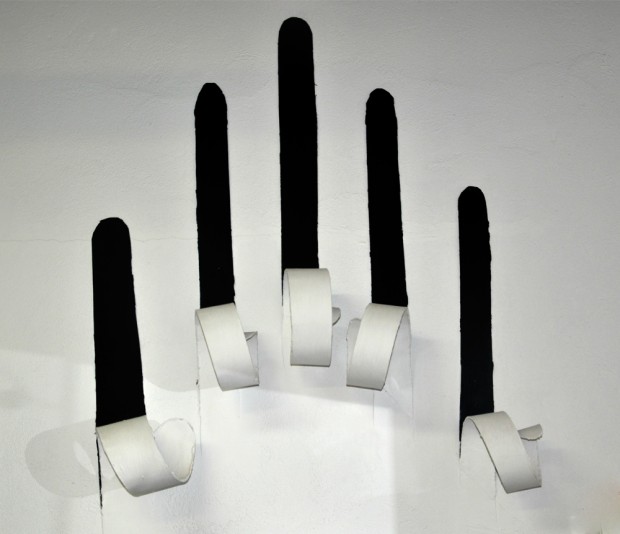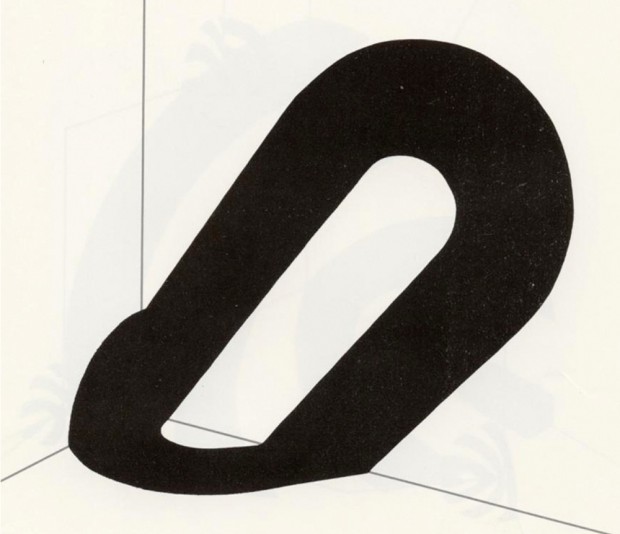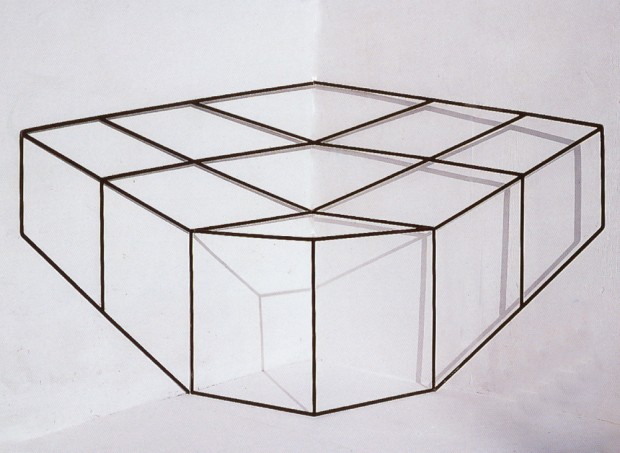[:es]OTROS LÍMITES
Sala San Antonio Abad
15 Abril – 5 Mayo 1992
El Oficio del Cero
Es articular la nada.
(Sergio Domínguez Jaén,
"Del Oficio del Cero”, 1986.)
La realidad no era, pero se ha convertido en ser.
El ser es síntesis de ser y de la nada.
Si aceptamos, con Hegel, que el Ser y la Nada son meros objetivos de un sistema en proceso. Que el Arte no es algo estrictamente material, que es el decurso transitable de la idea manifestándose en lo sensible. Es decir, si partimos del concepto de Arte como la colisión entre la vivencia existencial y la vivencia real, en la que el objeto no es algo puramente “exterior” ni tampoco simple contenido, llegamos a poder trazar la frontera desde la obra de este creador.
Domingo Díaz, nacido en Las Palmas en 1959, apenas nos permite alongarnos entre la percepción de los solares en los que radican sus esculturas y el objeto de su producción. Aferrado a estructuras metálicas, su obra se apodera del espacio circundante con una voracidad ajena a nuestro tiempo. Sus construcciones van mucho más allá del referente “minimal” al superar aquel endogámico sistema en aras de una nueva expresión. Díaz retoma de la escultura de los 60 y 70 su preocupación por los límites de la obra. Sin embargo, su personal linea de investigación apenas si podría contar con el paralelo formal de un escultor como Nigel Hall.
[:en]
OTHER LIMITS
FRANK GONZÁLEZ
San Antonio Abad Room. From April 15Th to May 5th , 1992.
El Oficio del Cero (the work of zero
Es articular la nada. is articulate nothing)
(Sergio Domínguez Jaén,
"Del Oficio del Cero”, 1986.)
The reality wasn’t but it has become in being.
The being is the synthesis of being and nothing.
If we accept with Hegel, that Being and Nothing are just aims of a system in process. That Art is not something strictly material, that is the passable course of the idea expressed in what is sensitive. I mean, if we start from the concept of Art as a clash between existential living and real living, in which the object is not anything purely “exterior” but simply content either, we can draw the border from this creator’s work.
Domingo Díaz was born in Las Palmas in 1956, and he hardly let us lean between the perception of the lands where he shows his sculptures and the object of his production. Clinging to metal structures, his work owns the surrounding space with a voracity foreign to our time. His constructions go beyond the “minimal” referent by overcoming that endogamic system in honor of a new expression. Díaz takes up again from 60s and 70s sculptures their concern for the limits of the work. However, his personal line of investigation could hardly rely on the formal parallel of a sculptor such as Nigel Hall.
[:es]Díaz invierte la pirámide de la creación para situarse a si mismo como volumen de sus proyecciones, como la estela del arañazo, como el espejo de sus fracturas. de este modo, los límites, la frontera, queda enmarcada por todo nuestro propio territorio visual. La austeridad reclama un modelo de arquitectura racional. Sin embargo, y de alguna manera, en su obra resuenan algunos lugares comunes de nuestra cultura. En él regresan y pugnan por igual el arquitecto Miguel Martín y el pintor Juan Ismael. La búsqueda de lo que queda dentro de las mallas matemáticas. El hueco recuperado como soporte de estructuras ausentes.
La fragmentación de su realidad, del propio paisaje, se articula en esquinas que no conducen hacia otro vértice que el primario. Como en la Obra de Luis Palmero, el signo ha sido despojado de su carácter. Su bicromismo desnuda al espectador de alternativas. sus estructuras de la memoria se articulan en torno a la eventualidad del momento, al movimiento en derredor de la pieza. Deambulatorios profanos que no persiguen otra cosa que la sombra del hierro. Es este carácter de inaccesibilidad el que apunta hacia el vértice único, al propio espectador. Sus esculturas superan la geometría para ocupar el soporte, el muro. Entre la pared y el espectador es en donde radica su interpretación del acontecer: “La realidad sólo tiene validez porque vivimos en ella.
Mundo de sombras provocado por el Mundo de las ideas, de las proyecciones. Rasgaduras de la violación del espacio último de la colectividad, Arañazos de búsqueda de lo que queda oculto siempre. Tras cada capa de pintura se regresa al primer reflejo del espejo. La búsqueda del otro devuelve una pálida y furtiva visión del nómada, que torna para habitar entre las proyecciones vacías.
Nuestra realidad ahora no permite otras concesiones. Su obra alcanza así la rara condición de símbolo de nuestro tiempo.
[:en]Díaz reverses the pyramid of creation to site himself like a volume of his projections, like the trail of a scratch, like the mirror of his fractures. In this way, the limit, the border is by all our own visual territory. The austerity claims a rational model of architecture. However, and in some way, in his work resound some of the common places of our culture. It makes come back and strive equally the architect Miguel Martin and the painter Juan Ismael. The search for what is inside of mathematics mail. The hollow is recovered as support of absent structures.
His reality fragmentation of the landscape in itself is articulated in corners that don’t lead to any other vertex but the primary. As happens in Luis Palmero’s work, the sign is taken off its character. The bichome strips off spectator’s alternatives. The structures of memories are articulated around eventuality of the moment, around movement in the work. Secular ambulatories don’t follow anything but the shadow of the iron. That inaccessible character points the only vertex, the spectator. The number, its rational form of language. His work, one more sign in language. A divested sign. His sculptures go beyond Geometry to take up the stand, the wall.


